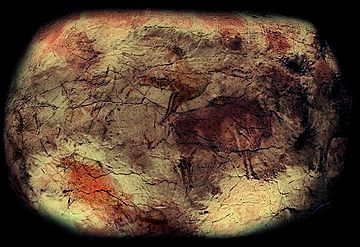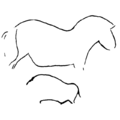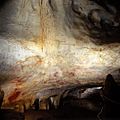Cave of Altamira and Paleolithic Cave Art of Northern Spain facts for kids
| UNESCO World Heritage Site | |
|---|---|

Replica of the Cave of Altamira at the National Archaeological Museum (Madrid)
|
|
| Location | Northern Spain |
| Includes |
|
| Criteria | Cultural: (i), (iii) |
| Inscription | 1985 (9th Session) |
| Extensions | 2008 |
| Buffer zone | 2,234.706 ha (5,522.08 acres) |
Imagine stepping back in time, thousands of years ago, to see amazing art created by early humans! The Cave of Altamira and Paleolithic Cave Art of Northern Spain is a special group of 18 caves in northern Spain. These caves hold some of the best examples of cave art from the Upper Paleolithic period in Europe. This art was made between 35,000 and 11,000 years ago.
In 2008, UNESCO recognized these caves as a World Heritage Site. This means they are very important to everyone in the world and need to be protected.
The most famous of these caves is Altamira. It is located in a town called Santillana del Mar in Cantabria. Altamira has some of the most important prehistoric paintings ever found. The art in Altamira is known for being very realistic, especially the animals. Altamira Cave was first named a World Heritage Site in 1985. Later, in 2008, 17 more caves were added to this special list. These caves are found in three different regions of northern Spain: Asturias, Cantabria, and the Basque Country.
Contents
What is Paleolithic Cave Art?
Paleolithic cave art refers to drawings and paintings made by early humans during the Stone Age. The word "Paleolithic" means "Old Stone Age." People used natural colors from minerals and plants to create images of animals like bison, horses, and deer. They also drew human hands and mysterious symbols.
These artworks were often made deep inside caves, where there was no natural light. Scientists believe these paintings might have been part of rituals, stories, or ways to teach younger generations about hunting and their world.
Why are These Caves Special?
The caves in Northern Spain are special because they show how skilled prehistoric artists were. The paintings are incredibly detailed and often use the natural bumps and curves of the cave walls to make the animals look more real. This style is sometimes called the Franco-Cantabrian school of art.
The art in these caves gives us clues about how people lived thousands of years ago. It shows us what animals were important to them and what they thought about their world. It's like a window into the past!
Exploring the Caves of Northern Spain
There are 18 caves in this World Heritage Site. Each one has its own unique art and history. While many of the original caves are closed to protect the delicate artwork, some have amazing replicas or special visiting rules.
Here are some of the important caves in this group:
- Altamira Cave: Famous for its "Great Hall of Polychromes" with incredible bison paintings.
- Cueva de la Peña de Candamo: Known for its large deer and horse figures.
- Cueva de Tito Bustillo: Features impressive paintings of horses and reindeer.
- Cueva de La Covaciella: Contains a group of bison drawings.
- Cueva del Pindal: Unique for its drawings of fish and a mammoth.
- Cueva de Hornos de la Peña: Has engravings of animals and human-like figures.
- Caves of Monte Castillo: This group includes several caves like El Castillo, Las Monedas, La Pasiega, and Las Chimeneas. They show art from different periods, including some of the oldest cave art known.
- Cueva de La Garma: This cave is like a time capsule, with well-preserved art and objects on the cave floor.
- Cueva de Santimamiñe: Located in the Basque Country, it has beautiful drawings of bison and bears.
- Cueva de Ekain: Famous for its detailed horse drawings.
These caves are found across different regions, including Asturias, Cantabria, and the Basque Country. Each region has contributed to this amazing collection of prehistoric art.
Protecting Ancient Art
Because the cave art is so old and fragile, it needs a lot of protection. Things like changes in temperature, humidity, and even the breath of visitors can damage the paintings. This is why many of the original caves are closed to the public or have very limited access.
To allow people to experience this incredible art, scientists and artists have created amazing replicas. For example, there's a fantastic replica of the Altamira Cave near the original one. This way, you can see the art almost exactly as it was, without harming the real thing.
These caves are a precious part of human history, showing us the creativity and skill of our ancestors. They remind us of the long journey of human art and culture.
See also
 In Spanish: Cueva de Altamira y arte rupestre paleolítico de la cornisa cantábrica para niños
In Spanish: Cueva de Altamira y arte rupestre paleolítico de la cornisa cantábrica para niños
- National Museum and Research Center of Altamira
- Caves in Cantabria
- Franco-Cantabrian region
- Art of the Upper Paleolithic
- List of Stone Age art
Images for kids


















